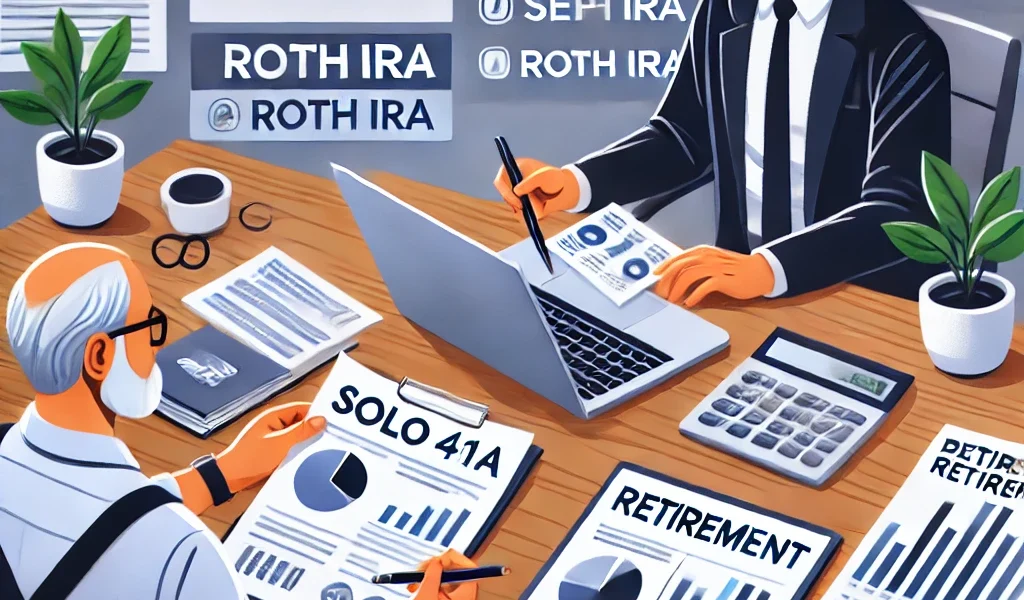Introduction
Being self-employed comes with many advantages, including flexibility, independence, and control over your income. However, it also comes with the responsibility of planning your own retirement, as you don’t have access to employer-sponsored retirement plans like a traditional 401(k) or pension. Without proper planning, self-employed individuals risk financial insecurity in their later years.
This guide will explore key retirement strategies for self-employed professionals, covering different retirement plans, savings tips, and investment strategies to help you secure a comfortable future.
1. Understanding the Challenges of Retirement Planning for the Self-Employed
Unlike employees working for companies, self-employed individuals must: ✅ Save for retirement without employer contributions. ✅ Handle their own tax obligations and deductions. ✅ Manage income fluctuations that may affect savings consistency. ✅ Select the right investment options to grow their retirement fund.
Despite these challenges, self-employed professionals have access to multiple tax-advantaged retirement savings options that can help them build a strong financial foundation.
2. Best Retirement Plans for Self-Employed Professionals
1. Solo 401(k) Plan
- Ideal for self-employed individuals with no employees (except a spouse).
- Allows both employer and employee contributions.
- Higher contribution limits than traditional 401(k) plans.
- Traditional (pre-tax) and Roth (post-tax) options available.
✅ Contribution Limits (2024):
- Employee contribution: Up to $23,000 (or $30,500 if age 50+).
- Employer contribution: Up to 25% of net earnings.
- Total limit: $66,000 (or $73,500 if 50+).
2. SEP IRA (Simplified Employee Pension IRA)
- Designed for freelancers and small business owners.
- Easy to set up and maintain.
- Contributions are tax-deductible.
- No catch-up contributions for those 50+.
✅ Contribution Limits (2024):
- Up to 25% of net earnings.
- Maximum contribution: $66,000.
3. SIMPLE IRA (Savings Incentive Match Plan for Employees)
- Best suited for small businesses with fewer than 100 employees.
- Employers must match employee contributions up to 3% or contribute a fixed 2% for all employees.
- Lower contribution limits compared to a Solo 401(k) or SEP IRA.
✅ Contribution Limits (2024):
- Employee: Up to $16,000 ($19,500 if 50+).
- Employer: 3% matching or 2% non-elective contribution.
4. Traditional IRA & Roth IRA
- Available to all self-employed individuals.
- Traditional IRA offers tax-deferred growth, while Roth IRA provides tax-free withdrawals in retirement.
- Best suited for those earning under the income limits for Roth IRA eligibility.
✅ Contribution Limits (2024):
- Up to $7,000 ($8,000 if 50+).
- Income limits apply for Roth IRA contributions.
3. Key Strategies for Retirement Planning
1. Start Saving Early
One of the most effective ways to secure a comfortable retirement is to start saving early. The power of compounding allows your savings to grow exponentially over time. Even small contributions made consistently can lead to significant wealth accumulation.
2. Automate Contributions
Set up automatic transfers to your retirement account to ensure consistent savings. Many self-employed individuals experience income fluctuations, so contributing a fixed percentage of each payment can help maintain savings momentum.
3. Diversify Investments
- Invest in a mix of stocks, bonds, ETFs, and real estate.
- Avoid putting all your savings into one type of investment.
- Use low-cost index funds and diversified mutual funds for balanced growth.
4. Take Advantage of Tax Benefits
- Contributions to SEP IRAs, Solo 401(k)s, and Traditional IRAs are tax-deductible, reducing taxable income.
- Roth IRAs provide tax-free withdrawals in retirement.
- Consider hiring a tax professional to maximize deductions.
5. Build an Emergency Fund
Since self-employed professionals often have irregular income, having 6-12 months of living expenses saved in an easily accessible emergency fund ensures you won’t have to dip into retirement savings during tough times.
6. Plan for Healthcare Costs
Retirees often face high healthcare costs. Consider opening a Health Savings Account (HSA) to cover medical expenses tax-free while also serving as an additional retirement savings vehicle.
7. Keep Track of Your Retirement Progress
Regularly review your retirement plan and adjust contributions as your income grows. Use online financial calculators to estimate how much you’ll need for a comfortable retirement.
4. How Much Should You Save?
A good rule of thumb is to save 15-25% of your income for retirement. If you start later in life, you may need to increase contributions to catch up. The table below shows estimated monthly contributions needed to reach a $1 million retirement goal at different ages.
| Age Started | Monthly Savings (7% annual return) |
|---|---|
| 25 | $400 |
| 35 | $800 |
| 45 | $1,700 |
| 55 | $3,800 |
The earlier you start, the easier it is to achieve your retirement goals with smaller contributions.
5. Common Mistakes to Avoid
🚫 Not saving early enough – Delaying savings can result in needing much higher contributions later. 🚫 Ignoring tax benefits – Take full advantage of tax deductions to maximize savings. 🚫 Relying only on Social Security – Social Security alone is unlikely to be enough for a comfortable retirement. 🚫 Not diversifying investments – Avoid putting all savings into one asset class. 🚫 Skipping financial planning – Regularly reassess your retirement plan based on income changes.
Conclusion
Self-employed professionals must take a proactive approach to retirement planning. With the right strategy—starting early, leveraging tax-advantaged accounts, diversifying investments, and maintaining financial discipline—you can build a secure and comfortable retirement.
Don’t wait—start planning today! The sooner you begin, the more financial security you’ll have in your later years. Consider consulting a financial advisor to tailor a retirement strategy that fits your needs and lifestyle.




